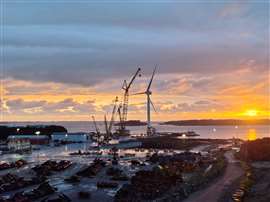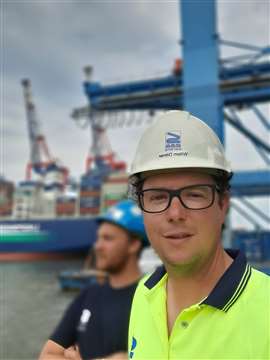Blowing in the wind: how heavy lifting firms are gearing up for the next expansion in offshore turbines
14 October 2024
With blades as long as football fields and standing as tall as the Eiffel Tower, floating offshore wind turbines are creating a plethora of technical challenges for heavy lifting firms. But perhaps the most challenging calculation they face is trying to work out what equipment they will need over the coming years to satisfy demand for such lifts. Lucy Barnard asks Sarens how it is shaping its fleet to account for evolving turbine technology and increasingly challenging carbon emissions targets.
 Hywind Scotland. Photo: Sarens
Hywind Scotland. Photo: Sarens
At the port of Wergeland on the west coast of Norway, teams of engineers are working on repairing not one but five behemoths.
Measuring 175 metres from sea surface to blade tip – plus another 78 metres below the surface, the massive turbines, which have been towed to the port from near Peterhead in Scotland for routine maintenance work, are in fact far bigger than the country’s tallest skyscraper.
Yet towering above them all stands an even bigger monster – a Liebherr LR 12500-1.0 lattice boom crawler crane which can be spotted for miles around.
The 200 metre crane has been working over the summer, operated by Belgian lifting specialist Sarens helping to replace the bearings in all five turbines – a job which involves grabbing the enormous structure from the sea in something resembling a giant game of ‘hook a duck’ but also then working with great precision to remove the nacelles and blades from it.
Challenging lifts
“Our team needed to face the movement of the wind turbine in every direction as the buoyancy of the tower was moving up and down while the entire tower was moving both laterally and horizontally, pushed by the tides,” says Willem Ditmer, senior project manager at Sarens who helped mastermind the lifts. “Each component that had to be lifted off and on the wind turbine had a very small margin in relation to its surrounding components.”
Ditmer says the LR 12500-1, Liebherr’s 2,500 tonne capacity crawler, is particularly suited to the challenges of floating turbines and other offshore installations which tend to be larger than onshore ones.
“The LR12500-1 was the perfect crane to overcome all these challenges thanks to the accurateness and precision to operate,” he says. “We think this model is a real game changer.”
 Willem Ditmer. Photo: Sarens
Willem Ditmer. Photo: Sarens
For Sarens which stakes its reputation on its ability to complete the most complex and difficult lifts, perhaps one of the most challenging calculations is working out what equipment it will need over the coming years to satisfy demand for such lifts.
To do this, the company and its competitors must estimate both how turbine technology is likely to evolve over the coming years and also how likely governments are to meet increasingly challenging carbon emissions targets.
Traditional offshore wind farms which are rooted in the seabed are only practical in water up to 60 metres deep. But, by installing floating foundations which are tethered to the sea floor by cables, floating turbines can be installed in waters of far greater depth – potentially opening up new frontiers in electricity generation.
While ordinary offshore turbines dwarf those built on land with blades often three times the length of their onshore cousins, floating turbines make even these seem small. Blades for some of these monsters are as long as football fields, bringing even more lifting challenges.
So far, the numbers are relatively small, with only a handful of operational farms and prototypes around the world; As well as Hywind Scotland’s five turbines which have a total capacity of 30 MW, five more floating turbines off the coast of Aberdeen at Kincardine have a capacity of 50 MW. Another three turbines off the coast of Portugal, dubbed Windfloat Atlantic have a capacity of 25 MW. Hywind Tampen, a floating offshore wind farm of 11 turbines 140 km off the coast of Norway have added a capacity of 88 MW since 2023. And China’s first floating wind project, the 200 metre high Haiyou Guanlan facility, moored in the Beibu Gulf, was commissioned in May 2023.
Henry Vermeulen, director of business development at Sarens, is one of the people responsible for trying to work out future heavy lifting demand. He forecasts that floating wind installations could become a far larger part of the business due to their massive power generation capabilities.
“It’s really difficult to know how lifting and construction equipment requirements are likely to change,” he says. “In the last few years, we’ve seen that demand is increasing drastically for offshore wind farms. I’m sure that the offshore landscape’s greatest challenges will start once floating wind becomes more frequent, we’ll face jobs with heavier foundations so the way we lift them will also evolve. I think fixed heavy lift (ring) pedestal cranes will be required.”
 Henry Vermeulen. Photo: Sarens
Henry Vermeulen. Photo: Sarens
Under the Paris Agreement, a legally binding international treaty aimed at keeping climate change within 1.5 degrees above pre-industrial levels, which was signed by 195 governments around the world in 2016, countries are required to publish nationally determined contributions (NDCs), detailing targets and policies on all of the carbon emissions they produce. These include plans for increasing the amount of renewable energy each country plans to generate.
In December 2023, nearly 200 countries at the COP23 climate summit in Dubai agreed to triple renewable power generation by the end of the decade to reach 11,000 GW by 2030, with solar and wind power accounting for 90 per cent of additions.
Solar farms currently account for 1,098 GW of installed global capacity while solar panels installed on roofs make up another 851.4 GW. Onshore wind turbines account for 1,029.3 GW and offshore turbines make up another 95.7 GW.
The International Energy Agency forecasts that, in line with government targets, all of those sectors will roughly double in capacity, reaching around 8,000 GW by 2030 with offshore wind showing the largest overall increase.
Yet headwinds in the industry continue to blow in the opposite direction with manufacturers facing increase costs in building and installing wind turbines due to rising materials prices combined with rising interest rates and difficulties obtaining the necessary permits.
The difficult market conditions have led to a spate of major off shore projects around the world being cancelled.
Challenges facing the industry
According to BloombergNEF, more than half of all US offshore wind power contracts were cancelled or at risk of cancellation in 2023. These included Danish turbine manufacturer Ørstead’s high profile cancellation of the Ocean Wind 1 and 2 projects off the coast of New York at a cost of more than US$3 billion in 2023 and the cancellation of BP and Equinor’s deal on the 1.2 GW Empire 2 Wind project.
For floating wind turbines the challenges are likely to be even greater. Floating turbines are far more expensive to manufacture than fixed ones and the technology is still in its infancy. This means to install them governments are having to pay more in subsidies. A September 2024 auction of offshore turbine contracts in the UK included subsidies of £195 (US$ 255) per MWh (see box).
Nonetheless, Vermeulen says Sarens is gearing up its fleet capable of taking on these sorts of complex offshore jobs.
Since taking delivery of its first LR 12500-1 in April 2023, Sarens added a second unit and is awaiting delivery of the third.
“So far, Sarens has sufficient capacity to handle all lifting weight demands,” says Vermeulen. However, we continue to encounter limitations at the quays where we operate, as many are not yet equipped to support our operations or lack the deep waters required for the vessels needed to load wind farm foundations.”
“The main challenge we’re currently facing is the lack of standardisation in turbine MW, making it nearly impossible to anticipate project requirements in advance.”
Renewable energy targets
China: Over the past couple of years, China is the country which has seen by far the most activity in terms of both wind farm and solar installations. A decade ago, China relied on fossil fuels for two thirds of its power generating capacity but over the last four years, clean energy has emerged as a top driver for economic growth. In 2020 Chinese premier Xi Jinping announced to the UN General Assembly that the country’s aim was that non-fossil energy sources will account for more than 80 per cent of total energy consumption by 2060. To do this, he announced a target of 1,200 GW of energy capacity to come from renewable sources by 2030. In the four years since then, China has powered ahead with ambitious investments in clean energy, building huge solar power bases and onshore wind farms in areas such as the Gobi Desert – so much so in fact that fossil fuels now make up less than half the country’s total installed generating capacity. Mid-2024, the IEA estimated that with nearly twice as many new wind and solar plants under construction in China as the rest of the world combined, the country is on track to reach its target by the end of 2024 – six years early.
The EU: In the European Union too, a longstanding frontrunner in the fight against climate change, the need to offset cutbacks in Russian gas exports has also been encouraging a dramatic increase in the installation of photovoltaic cells and wind turbines. In 2020, the bloc surpassed its previous goal to reach 20 % of final energy consumption from renewables and in 2023 it revised its Renewable Energy Directive, establishing a new binding target for member states that at least 42.5 % of gross final energy consumption must come from renewable energy sources by 2030. Lobby group Wind Energy Europe says even though the EU 27 installed a record 16.2 GW of turbine capacity in 2023, the bloc needs to be 29 GW on average to meet current targets.
USA: In stark contrast stands the USA, which withdrew from the Paris Agreement in 2020 under the leadership of Donald Trump but rejoined a year later when Joe Biden came to power. One of Biden’s first major acts as president was to announce an ambitious goal to reduce net greenhouse gas emissions by 50-52 % below 2005 levels in 2030 – nearly doubling those made by Trump’s predecessor Barak Obama. Under the Biden administration’s plans, the USA hopes to reach a goal of 80 % carbon-free and pollution-free electricity by 2030 and 100 % by 2035. The president’s Inflation Reduction Act established a number of clean energy incentives designed to encourage the development of more solar and wind farms as well as battery storage projects and in 2021, Biden signed an executive order requiring federal agencies to procure 100 % carbon-free and pollution-free electricity by 2030. One of the key pillars of Biden’s climate pledge was his 2021 promise to boost the country’s fledgling offshore wind industry to deploy offshore wind turbines capable of generating 30 GW of power by 2030 which equates to more than 2,000 turbines. Around the middle of 2024, however, the American Clean Power Association (ACP) forecast that by the end of the decade the country will only have installed about 14 GW of offshore wind capacity after costly delays and rising project costs prompted manufacturers to cancel or renegotiate contracts.
UK: As part of its Nationally Determined Contribution, the UK has committed to a 68 % reduction in emissions by 2030 compared with a 1990 baseline. The country’s new Labour goverment has committed to doubling onshore wind from 15 to 30 GW by 2030 and quadrupling offshore wind from 15 to 60 GW. In September the UK government secured 131 new clean energy projects in a £1.5 billion (US$2 billion) auction.
STAY CONNECTED



Receive the information you need when you need it through our world-leading magazines, newsletters and daily briefings.
CONNECT WITH THE TEAM








